Apollo 10
Day 4, part 12b: Lunar encounter - Lunar Orbit Insertion
Corrected Transcript and Commentary Copyright © 2010-2022 by W. David Woods, Robin Wheeler and Ian Roberts. All rights reserved.
Last updated 2022-02-12
075:46:47 Stafford (onboard): Okay. I'll put this under my back, back here, Gene-o.
075:46:51 Cernan (onboard): Okay.
075:46:52 Stafford (onboard): The criteria for overburn is 10 seconds. At Loss Of Signal, you got the DSE [Data Storage Equipment] - if no DSE motion, go to [garble] Command Reset then Normal. You got that?

Up Telemetry Command Reset switch - Panel 3.
075:47:03 Cernan (onboard): Okay there it is, we've got it, so we're okay.
075:47:05 Stafford (onboard): Yes, okay. The only thing we've got left now is - to go...
075:47:12 Cernan (onboard): You're on - you're on tape by the way.
075:47:14 Stafford (onboard): That checks. Okay, we're on tape.
075:47:15 Young (onboard): You're on High Bit Rate now?
075:47:16 Cernan (onboard): No, but we got the DSE running.
075:47:18 Young (onboard): Okay, I'm going to run through these checks just one more time...
075:47:20 Cernan (onboard): Yes, go ahead.
075:47:21 Young (onboard): ...the EMS Delta-V check; the EMS Delta-V is set. 2975.2, right?
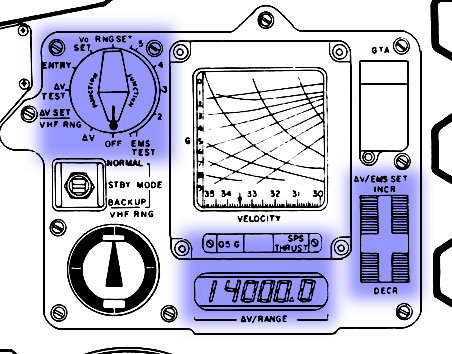
EMS switches and displays used to monitor SPS burns - Panel 1.
075:47:26 Stafford (onboard): Yes.
075:47:27 Young (onboard): BMAGs, three, to Rate 2; go. LM/CM, Delta-V CG, no RCS Selects are set.
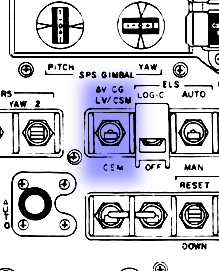
Delta-V CG switch - Panel 1
075:47:34 Cernan (onboard): [Cough].
075:47:35 Young (onboard): The DAP is set and loaded.
075:47:36 Cernan (onboard): Yes.
075:47:37 Young (onboard): Spacecraft Control, CMC and Auto.
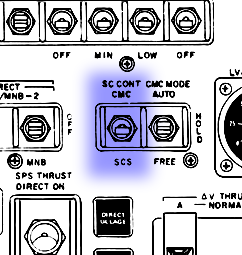
SC CONT CMC Mode switch - Panel1
075:47:39 Cernan (onboard): Yes.
075:47:40 Young (onboard): Maneuver to burn attitude - we've done that; we've done that - boresight star; we've done the sextant star check; we done - we ain't got no boresight star, come to think of it. We've maneuvered to the attitude; panel 8, SCS breakers are Closed...
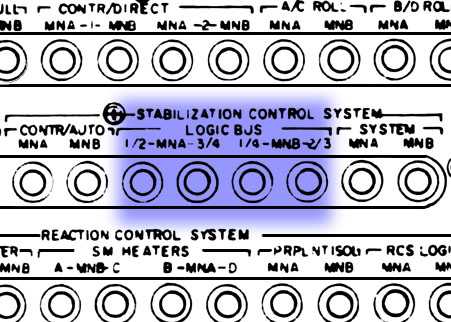
The SCS Logic Bus circuit breakers - Panel 8.
075:47:56 Stafford (onboard): Are Closed. [Garble] okay.
075:47:58 Young (onboard): Manual Attitude, three, Rate Command is Go. Limit Cycle switch is Off - Doesn't make any difference...

Manual Attitude, Limit Cycle, Att Deadband Rate and Trans Contr Power switches - Panel 1.
075:48:03 Stafford (onboard): [Garble.]
075:48:04 Young (onboard): Deadband, Min Rate is High. Translation Control Power is On, in case we have to get Att through the SCS; AC 1, okay; Rotational Control Power, Directs, are Off; Spacecraft Control, CMC and Auto again; SCS TVCs in Rate Command; TVC Gimbal Drives in Auto. And wait for 6 minutes. That was Loss Of Signal right there.
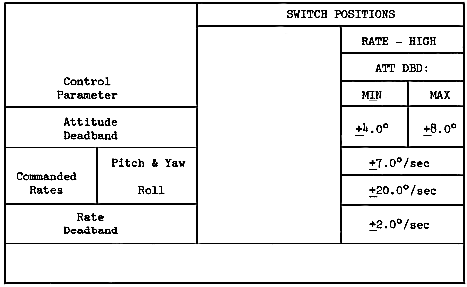
Attitude rates
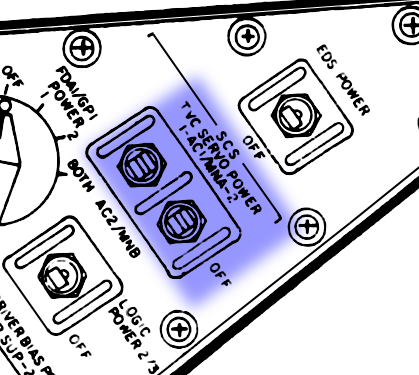
Thrust Vector Control (TVC) power switch - Panel 7.
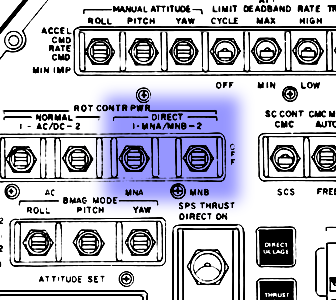
Rotation Controller Power switches - Panel 1.
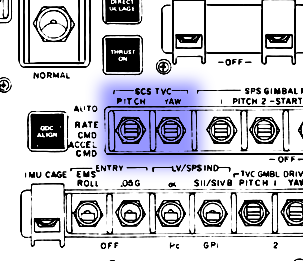
SCS Thrust Vector Control (TVC) switches - Panel 1.
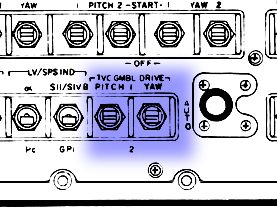
Thrust Vector Control (TVC) Gimbal Drive switches - Panel 1.
075:48:26 Cernan (onboard): Yes. Yes, that was it, babe.
075:48:27 Young (onboard): That was it! Lost it.
075:48:30 Stafford (onboard): We're on our own now.
075:48:32 Cernan (onboard): You see anything over the top, Tom?
075:48:33 Stafford (onboard): No. Sure I'm not even going to look.
075:48:34 Cernan (onboard): Did you hear that? Man, we lost them in a hurry.
075:48:36 Young (onboard): Yes, it went off in a hurry.
075:48:38 Cernan (onboard): What's the configuration in the Flight Plan for acquiring them around the other side; does it say, Tom? I'll go into that - Oh, that's the High Gain, right?
075:48:44 Stafford (onboard): Right.
075:48:45 Cernan (onboard): We'll be in a special, attitude, and I'll be able to pick them up High Gain, right?
075:48:48 Stafford (onboard): We roll 180, pitch...
075:48:50 Cernan (onboard): And then High Gain.
075:48:51 Stafford (onboard): ...pitch is minus 86, yaw is zero.
075:48:54 Cernan (onboard): Verb 64
, acquire for MSFN
. Okay, fine; I'm all set.
075:48:58 Stafford (onboard): Okay
, you've got a minus 86 degrees...
075:49:00 Cernan (onboard): I got it in there.
075:49:01 Stafford (onboard): Okay. And minus - yaw is - is...
075:49:02 Cernan (onboard): Okay.
075:49:03 Stafford (onboard): ...minus 7. Okay. Now, let me see just - again, the EMS is in, the RCS Logic - we got the helium - the pilot valves are in. All those good things are in...
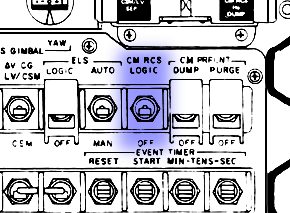
CM RCS switch - Panel 1.
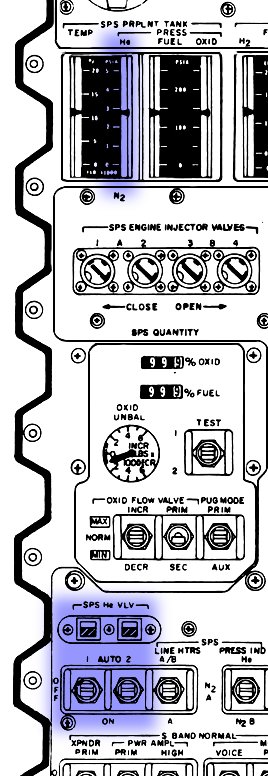
SPS Helium Valve switches and He pressure meter - Panel 3.

Helium Valve and Pilot Valve circuit breakers - Panel 8.
075:49:12 Young (onboard): Yes, all those things are in because if they ain't, nothing happens.
075:49:16 Stafford (onboard): Yes.
075:49:17 Cernan (onboard): Okay, we got the Bus Ties to go over here.
075:49:19 Stafford (onboard): Okay, and we got the Bat Relay Bus and all those.

Battery Relay Bus circuit breakers - Panel 5.
075:49:22 Cernan (onboard): That's all in. Everything that I can see over here is in that should be in.
075:49:26 Stafford (onboard): Okay, we're up to 6 minutes.
075:49:28 Cernan (onboard): And, John, I'll give you a call through mode 1, mode 2, and...
075:50:19 Young (onboard): Roger.
075:50:20 Stafford (onboard): You want to go ahead and be ahead of it? Or not?
075:50:22 Young (onboard): I don't see much sense in doing it.
075:50:36 Cernan (onboard): Oh, dear.
075:50:47 Stafford (onboard): Okay.
075:50:48 Stafford (onboard): Okay, 5 minutes, Gimbal...
075:50:49 Young (onboard): Pitch Motor number 1 is coming On, Gene-o.
075:50:52 Cernan (onboard): Okay, stand by. Go. That's go.
075:50:56 Stafford (onboard): Yaw 1.
075:50:57 Young (onboard): Yaw 1 is coming On.
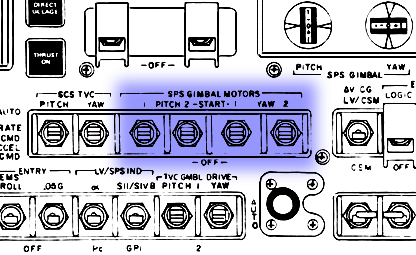
SPS Gimbal Motors, Pitch and Yaw - Panel 1.
075:50:58 Cernan (onboard): That's go.
075:50:59 Stafford (onboard): Translational Control, clockwise...
075:51:00 Young (onboard): Translational Control, clockwise.
075:51:03 Stafford (onboard): ...verify no MTVC.
075:51:04 Young (onboard): We have no MTVC.
075:51:05 Stafford (onboard): Check TVC - secondary TVC check; Pitch 2.
075:51:09 Young (onboard): Coming On, Gene-o.
075:51:10 Young (onboard): Mark.
075:51:11 Cernan (onboard): That's go.
075:51:12 Stafford (onboard): Yaw 2, Start.
075:51:13 Young (onboard): Yaw 2, coming On.
075:51:15 Cernan (onboard): That's go.
075:51:16 Stafford (onboard): Set the trim.
075:51:17 Cernan (onboard): Should have all four, babe...
075:51:18 Young (onboard): Plus 95.
075:51:19 Stafford (onboard): And minus 17.
075:51:20 Young (onboard): Minus 17.
075:51:22 Stafford (onboard): Okay.
075:51:23 Young (onboard): Okay.

SPS Gimbal trim panel in the Apollo 13 Command Module, Odyssey.
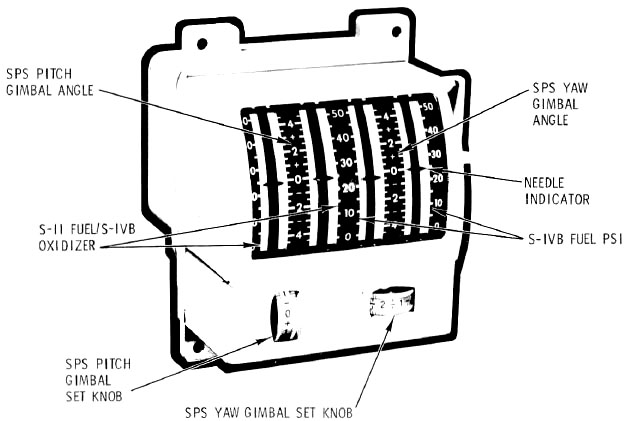
SPS gimbal trim thumb wheels and Gimbal Position Indicator (GPI) displays - Panel 1.
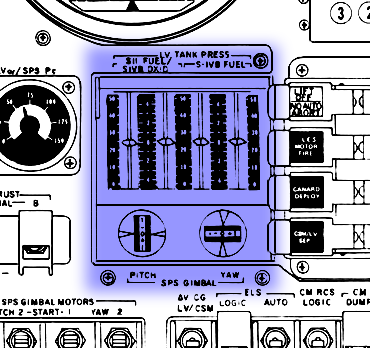
SPS gimbal trim thumb wheels and Gimbal Position Indicator (GPI) displays - Panel 1.
075:51:24 Stafford (onboard): Check MTVC, would you, John? Something's shaking.
075:51:31 Cernan (onboard): That's got...
075:51:32 Young (onboard): The old big bell, babe. GPI to neutral.
075:51:34 Stafford (onboard): GPI to neutral.
075:51:35 Young (onboard): Go to zero.
075:51:37 Stafford (onboard): Rotational Control Power, number 2, AC/DC.
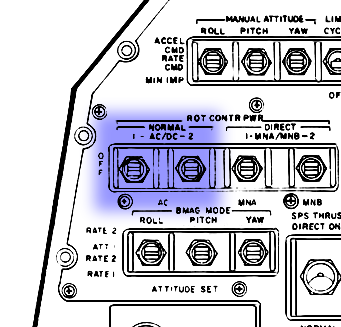
Rotation Controller power switches - Panel 1.
075:51:41 Young (onboard): AC/DC. We checked the boresight star?
075:51:42 Stafford (onboard): We don't have that?
075:51:43 Young (onboard): Okay, Auto gimbal check.
075:51:45 Stafford (onboard): Okay. Oh, do you want one final trim here?
075:51:48 Cernan (onboard): No. We don't need that.
075:51:51 Young (onboard): Yes. There you go.
075:51:56 Stafford (onboard): Okay, Enter?
075:51:57 Young (onboard): Enter.
075:51:58 Cernan (onboard): You're back in neutral on your controller, huh?
075:51:59 Stafford/Young (onboard): Yes.
075:52:00 Cernan (onboard): Okay.
075:52:01 Stafford (onboard): 204, ready?
075:52:02 Young (onboard): Yes.
075:52:03 Stafford (onboard): Plus 2, minus 2, and zero. Plus 2, minus 2, and a zero.
075:52:13 Cernan (onboard): Oh, I tell you; that mother really moves around, doesn't it?
075:52:16 Young (onboard): Trim that moves it.
075:52:21 Cernan (onboard): Okay, y'all.
075:52:22 Stafford (onboard): 03:30. Okay, 6 [garble] 40 okay - Rotational Control Power, Direct, MN A/MN B.

Rotation Controller power switches - Panel 1.
075:52:29 Young (onboard): That's go.
075:52:30 Stafford (onboard): SPS Helium Valves, two, Auto.
075:52:31 Young (onboard): They are Auto. Limit Cycle switch to Off.
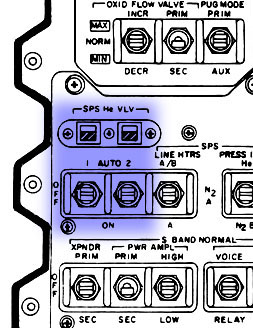
SPS Helium Valves, Auto switches - Panel 3.
075:52:33 Stafford (onboard): Limit Cycle switch is Off. FDAI is what you wanted?
075:52:35 Young (onboard): Yes. GDC Align, right?
075:52:37 Stafford (onboard): Yes, GDC Align.
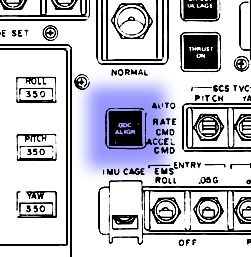
GDC Align push button - Panel 1.
075:52:40 Young (onboard): I've got 351 here, now.
075:52:46 Stafford (onboard): Coming in.
075:52:51 Young (onboard): Okay.
075:52:52 Stafford (onboard): BMAGs, three, Att 1/Rate 2.
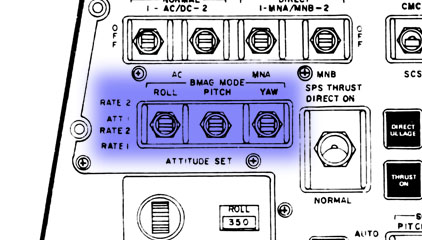
Three BMAG Mode switches - Panel 1.
075:52:55 Young (onboard): Okay.
Mark. 3 minutes to LOI burn. We won't know how this maneuver has gone until we acquire Apollo 10 as it comes around the front of the Moon.
075:52:58 Stafford (onboard): Okay, minus 2 minutes, John.
075:53:04 Cernan (onboard): Still don't see nothing, huh, Tom?
075:53:06 Stafford (onboard): Shit, no! And I don't care to see anything now. Not much to see...
075:53:09 Cernan (onboard): Okay, your trim's set, John?
075:53:11 Young/Stafford (onboard): Yes.
075:53:18 Cernan (onboard): Was it plus 0.95 and a minus 0.17?
075:53:21 Young (onboard): Yes.
075:53:22 Cernan (onboard): Okay.
075:53:23 Stafford (onboard): Okay, at 2 minutes, Delta-V Thrust, A and B, Normal.
075:53:27 Young (onboard): A, Normal, right?
075:53:28 Stafford (onboard): A, Normal. You can get the guard up on B.
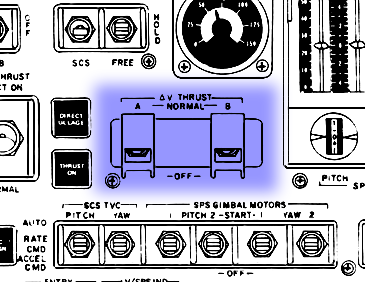
Delta-V Thrust switches - Panel 1.
075:53:44 Cernan (onboard): Sure is getting bright out there. I got the Moon's reflected surface in the LM window. I can see it in the LM window, the overhead window.
075:53:52 Stafford (onboard): Good show.
075:53:53 Cernan (onboard): It's down there, babe.
075:53:54 Stafford (onboard): Okay, 2 minutes, Delta-V Thrust, A, Normal; Translational Control Power, Armed.
075:53:59 Young (onboard): Translational Control Power is Armed.
075:54:01 Cernan (onboard): Look at the size of...
075:54:02 Young (onboard): Rotational Control Power is Armed. Okay, at 30 seconds...
075:54:05 Stafford (onboard): You don't have the Translation Armed.
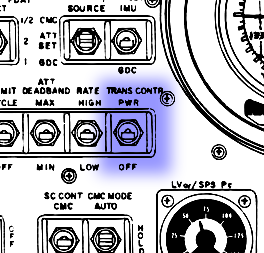
Translational Control Power switch - Panel 1.
075:54:07 Young (onboard): Yes, it is. No, there you go.
075:54:08 Stafford (onboard): Okay, at 30 seconds, EMS, Normal, and Delta - EMS Delta-V, Normal, and High Bit Rate.
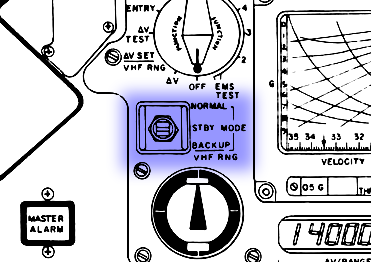
Entry Monitor System (EMS) Mode switch - Panel 1.
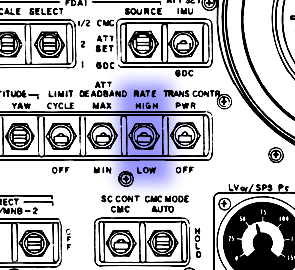
Rate switch - Panel 1.
075:54:14 Cernan (onboard): Okay, I'm really for it. God, that Moon is beautiful; we're right on top of it...
075:54:19 Stafford (onboard): Oh, shit!
075:54:20 Cernan (onboard): God dang. We're right on top of it. I can see it...
075:54:22 Stafford (onboard): Oh, shit; John! It looks like a big plaster-of-paris cast.
075:54:24 Cernan (onboard): I can see it reflected, babe - right in the LM overhead window.
075:54:29 Stafford (onboard): Okay, let's get busy...
075:54:30 Cernan (onboard): Okay, let's get this burn off. How much time?
075:54:35 Stafford (onboard): 1 minute and...
075:54:36 Cernan (onboard): 1 minute and 20, right? Okay.
075:54:37 Stafford (onboard): Oh, yes.
075:54:38 Cernan (onboard): You got it, Tom?
075:54:39 Stafford (onboard): You damn right I got it.
075:54:42 Cernan (onboard): Oh, I do, too.
075:54:43 Stafford (onboard): Okay, let's keep looking then.
075:54:44 Cernan (onboard): My God, that's incredible.
075:54:46 Stafford (onboard): It looks like we're close...
075:54:47 Cernan (onboard): That's incredible.
075:54:49 Stafford (onboard): It does look like we're - well, we're about 60 miles, I guess.
075:54:51 Stafford (onboard): Okay, 1 minute. Okay, let's go.
075:54:54 Cernan (onboard): It does look - look gray, doesn't it?
075:54:55 Stafford (onboard): Okay, 30 seconds; we'll get Delta-V, Normal.
One minute to LOI.
075:54:58 Young (onboard): Yes, and don't forget the High Bit Rate. Coming up...
075:54:59 Stafford (onboard): High Bit Rate.
075:55:00 Young (onboard): ...coming up whenever you go to Delta-V, Normal.
075:55:03 Stafford (onboard): Shit, baby; we have arrived - It's a big gray plaster-of-Paris thing...
075:55:07 Cernan (onboard): Oh, my God, that's incredible.
075:55:08 Stafford (onboard): Okay, let's keep going; we've got to watch this bear here.
075:55:10 Young (onboard): Put your head back in the cockpit, Gene-o.
075:55:11 Cernan (onboard): Look at that!
075:55:12 Stafford (onboard): Let's go.
075:55:13 Cernan (onboard): Okay, I'm ready.
075:55:14 Stafford (onboard): Okay, the High Bit Rate, go ahead; hit it.
075:55:15 Cernan (onboard): High Bit Rate...
075:55:33 Stafford (onboard): Okay, 22 seconds. Standing by to push the Thrust On. 18 seconds. Get your watch; we're all set, babe...
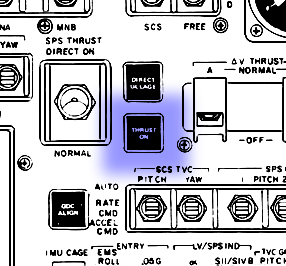
Thrust On push button - Panel 1.
075:55:42 Young (onboard): All set.
075:55:43 Stafford (onboard): ...Count us down, Gene-o. Delta-V to Normal; rechecked. Everything is good. Delta...
075:55:45 Cernan (onboard): 10 seconds.
075:55:46 Stafford (onboard): ...Okay, and get that On in 3 seconds. [Garble] Delta-V.
075:55:47 Cernan (onboard): Stand by.
075:55:48 Stafford (onboard): ...7...
075:55:49 Cernan (onboard): 5 seconds.
075:55:50 Stafford (onboard): 5, Proceed, 3, 2, 1...
5 seconds. Ignition. Apollo 10 should be burning now. And at that time of ignition, Apollo 10 was 98.4 nautical miles [182.2 km] from the Moon, 215,847 nautical miles [399,746 km] from Earth. We have 2 clocks counting in the control room now. The top clock reading AOS CM. It reads 25 minutes, 8 seconds. That's the acquisition of signal time with a good LOI burn. The bottom clock reads 14 minutes, 24 seconds and that is the acquisition time if Apollo 10 did not perform the burn. Flight Director Chris Kraft describes the attitude in this Control Center now as anticipatory. It's very quiet in this control room right now. A few conversations going but not very many. Most controllers sitting at their consoles very quietly. The entire Apollo 10 backup crew is here in the Control Center; Gordon Cooper, Donn Eisele, and Ed Mitchell. Two CapComs; Charlie Duke and Bruce McCandless. Jack Schmitt is still here. Deke Slayton, the Director of Flight Crew Operations is here talking at the moment with Dr. Robert Gilruth, the Director of MSC. George Low, the Apollo Spacecraft Program Manager is here with Chris Kraft, the Director of Flight Operations. Lt. General Samuel Phillips, the Apollo Program Director, is seated next to them. On the other side of General Phillips is George Hage, the Mission Director. We understand that Dr. Kurt Debus, the Director of the Kennedy Space Center and Dr. von Braun, the Director of the Marshall Space Flight Center are in the viewing room. We'll try to get a list of some of the other people in the viewing room. And this is Apollo Control. Among other distinguished visitors in the viewing room are Dr. George Mueller, the Associate Administrator for Manned Space Flight, NASA; Mr. Lou Evans, the President of Grumman Aircraft Engineering Corporation, the prime contractor for the Lunar Module; and the Vice President for Space of that company, Joe Gavin. The manufacturer of the Command Module Charlie Brown is represented by William Bergen, President of the Space Division of North American Rockwell. And Rusty Schweickart who was the Lunar Module Pilot on the Apollo 9 mission is in the viewing room.
075:55:55 Cernan (onboard): Okay, we're burning; you got good valves.
075:55:57 Stafford (onboard): Okay, bank the Delta-V...
075:55:58 Cernan (onboard): You got four good valves; you got four good valves. Helium Valves are Closed, you got four good valves.

SPS helium valve switches and talkback indicators - Panel 3.
075:56:05 Stafford (onboard): Guidance looks good.
075:56:07 Cernan (onboard): Guidance looks good. Boy, it's a soft burn right now. Come on, balance up, you mother. It's 15 seconds into the burn; she ought to start balancing now. Okay, and...
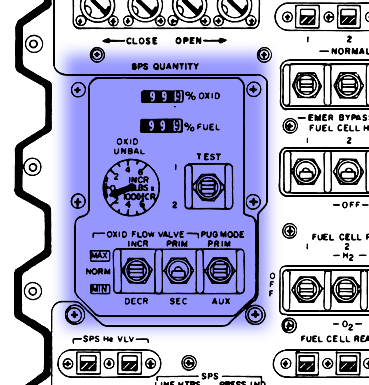
Oxidizer Unbalance meter and Oxidizer Flow Valve switches - Panel 3.
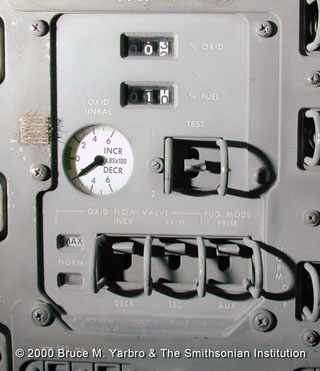
SPS propellant utilization panel - Panel 3.
075:56:16 Young (onboard): It's on now.
075:56:17 Cernan (onboard): ...chamber pressure's 95. Okay, all my pressures are looking good, babe.
075:56:22 Young (onboard): 75, 80, 85, 90...
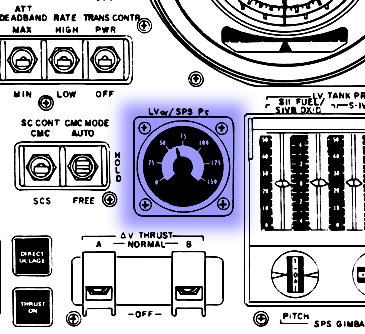
SPS PC meter - Panel 1.
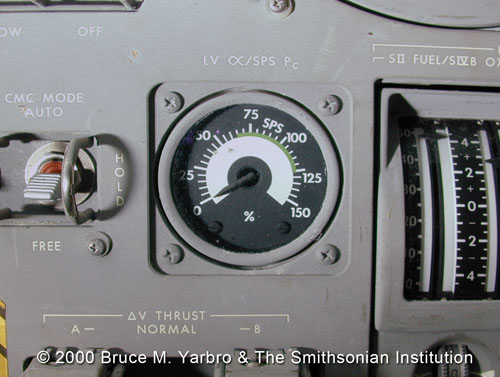
SPSPC meter in the Apollo 13 Command Module, Odyssey.
075:56:23 Cernan (onboard): Okay, we burn it for 30 [garble] on the A.
075:56:24 Young (onboard): ...we better start balancing that - the oxidizer here.
075:56:25 Stafford (onboard): Good.
075:56:27 Cernan (onboard): Okay, everything's looking good...
075:56:30 Stafford (onboard): Do you want...
075:56:31 Cernan (onboard): ...pressures are still good.
075:56:33 Stafford (onboard): Looking good at 30 seconds. EMS is agreeing with the G&N.
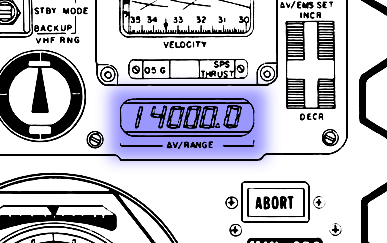
EMS Delta-V counter - Panel 1.
075:56:38 Cernan (onboard): Okay, she's balancing up nicely.
075:56:40 Young (onboard): Okay, chamber pressure's 97...
075:56:42 Stafford (onboard): Holding steady.
075:56:43 Young (onboard): ...and holding steady, and it jumped about 4 when it turned on the second bank. Gimbal motors is Go.
075:56:47 Cernan (onboard): Okay, four good banks, helium pressure's Go, and - fuel oxidizer pressures are Go.
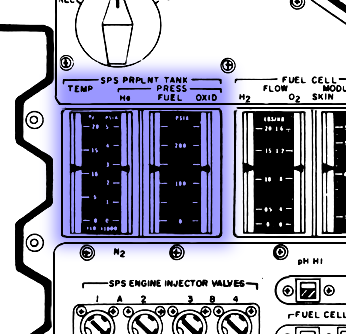
SPS temperature, helium, fuel and oxidiser pressure gauges - Panel 3.
075:56:54 Stafford (onboard): Gimbal motors have settled down a little bit.
075:56:55 Cernan (onboard): Balancing up really nice, John. The PUGS is working after 30 seconds. I turned it on. Looking good.
075:57:00 Young (onboard): Okay. Okay.
075:57:02 Cernan (onboard): Tank pressures are good.
075:57:03 Young (onboard): 98 psi. That's Go.
075:57:05 Cernan (onboard): Helium pressures are good.
075:57:06 Young (onboard): Okay.
075:57:09 Stafford (onboard): How's the nitrogen [garble]?
075:57:10 Young (onboard): Okay, that chamber pressure's coming up; now it's 100.
075:57:13 Cernan (onboard): I'm still looking good here. I got four valves and tank pressures are Go.
075:57:19 Stafford (onboard): You have 4 minutes.
075:57:20 Young (onboard): The roll is trimming out a little. How's your regulator pressure...
075:57:22 Cernan (onboard): 1 minute, 30 seconds into burn; we've got a - Regulated pressures all good.
075:57:27 Stafford (onboard): Things are looking good.
075:57:28 Cernan (onboard): Okay, John we're coming up at 01:40 at the end of mode 1.
075:57:31 Young (onboard): Okay.
075:57:33 Cernan (onboard): Okay, we're in no-man's land; 01:40; and everything's looking good.
075:57:36 Young (onboard): Our chamber pressure's up to 101 now.
075:57:41 Stafford (onboard): 04:14 to go.
075:57:42 Cernan (onboard): Okay, babe; let's get by 2 minutes. We're in no-man's land; everything's looking good.
075:57:47 Young (onboard): Alright.
075:57:50 Cernan (onboard): Everything's looking good. 01:55.
075:57:53 Stafford (onboard): Looking good.
075:57:54 Cernan (onboard): Boy, it's a nice soft burn; keep burning, baby...
075:57:55 Stafford (onboard): 2 minutes.
075:57:56 Cernan (onboard): 2 minutes.
075:57:57 Cernan (onboard): Mark. We're into mode 2. Okay, we're into mode 2.
075:58:00 Stafford (onboard): Okay.
075:58:02 Cernan (onboard): She's going on the Increase; I'm going to balance back the other way.
075:58:07 Stafford (onboard): Okay, I'm looking at the burn and what we have to do - It'll be 50.
075:58:11 Cernan (onboard): Okay, all my pressures here are holding good, John.
075:58:14 Young (onboard): Holding good here. We're up to 102 psi - chamber pressure. That little baby's getting better and better.
075:58:20 Stafford (onboard): 18 6 [garble] go. 18 7 [garble]...
075:58:25 Cernan (onboard): Come on, baby. Balance back down; balance back down...
075:58:28 Young (onboard): You approaching crossover yet, Gene-o?
075:58:29 Cernan (onboard): ...balance back down - No, I'm only at 72 percent, but I can't get that son of a bitch to balance back down. Here it comes. Come on, baby.
075:58:38 Young (onboard): Don't lean on...
075:58:39 Cernan (onboard): 70 percent. Everything's looking good here.
075:58:44 Stafford (onboard): 3 minutes - to burn.
075:58:48 Stafford (onboard): If the G&N's right, we'll burn...
075:58:51 Cernan (onboard): Coming up to 3 minutes, John.
075:58:52 Stafford (onboard): 3 55 [garble].
075:58:54 Young (onboard): [Garble]. Okay.
075:58:55 Stafford (onboard): [Garble]. 5 56.
075:58:56 Young (onboard): Mark it, 3 minutes.
075:59:00 Cernan (onboard): Come on, baby. Get that thing going.
075:59:02 Young (onboard): Yaw's off in roll. See that?
075:59:04 Stafford (onboard): Yes, I saw that, John.
075:59:05 Young (onboard): Okay, we're up to 102 pounds now. Son of a gun's just getting better all the time.
075:59:11 Stafford (onboard): Yes.
075:59:12 Young (onboard): That's the roll thruster firing to bring it back in.
075:59:14 Cernan (onboard): Okay, your - all your pressures are looking good right now. Except I can't get that increase now. Come on, baby. I don't want to switch to secondary valve yet, because it's not off that far.
075:59:24 Young (onboard): What secondary valve? Don't go on a backup.
075:59:26 Cernan (onboard): No, no, it's still slowly in the - Everything's looking good; you're at 3 minutes and coming up on 40 seconds.
075:59:34 Stafford (onboard): Coming up - coming up to 2 minutes to go, John. It's looking good. Beautiful, baby.
075:59:38 Young (onboard): My God, there it is.
075:59:40 Stafford (onboard): Oh, you'd better believe it.
075:59:41 Cernan (onboard): There it is, is right...
075:59:42 Stafford (onboard): Strangest looking son of a bitch I've ever seen.
075:59:44 Young (onboard): Isn't that weird?
075:59:45 Stafford (onboard): Okay, let's go. 2 minutes to go. Looking good.
075:59:47 Cernan (onboard): Okay, all your valves are still good. 102.
075:59:50 Stafford (onboard): 2.
075:59:51 Cernan (onboard): 102 on the psi.
075:59:52 Stafford (onboard): I'm estimating that the G&N is going to be about...
075:59:55 Cernan (onboard): Okay, we're at crossover right now on the - on the propellants.
075:59:57 Young (onboard): Okay, and don't pay any attention to what it's...
075:59:58 Stafford (onboard): Don't worry; we're about [garble]...
076:00:00 Young (onboard): 102.
076:00:01 Stafford (onboard): I'm going to estimate 5 plus; 58 for the burn.
076:00:04 Young (onboard): Okay. Okay, there's 4 minutes and coming up on 15 seconds.
076:00:10 Stafford (onboard): Yes.
076:00:14 Cernan (onboard): Oh, would you believe it? There's the lunar horizon.
076:00:16 Stafford (onboard): Okay, how's the - propellant tanks are looking good.
076:00:18 Cernan (onboard): Everything's looking good, babe.
076:00:19 Young (onboard): Helium's up to 103. 104.
076:00:23 Stafford (onboard): First I've heard of a bloody engine going up...
076:00:26 Young (onboard): Okay, there's...
076:00:27 Stafford (onboard): ...[garble].
076:00:28 Young (onboard): ...[garble].
076:00:29 Stafford (onboard): Okay, we're getting down to 1 minute to go and - guidance is fantastic.
076:00:35 Young (onboard): Beautiful, just beautiful. Just beautiful.
076:00:39 Stafford (onboard): Beautiful guidance; you couldn't ask for any better.
076:00:41 Young (onboard): It's solid as a rock.
076:00:42 Cernan (onboard): Tank pressures are looking good.
076:00:43 Stafford (onboard): Okay, good. Fuel is holding good, Gene-o.
076:00:46 Cernan (onboard): Everything's looking good, babe. You're well into mode 3.
076:00:48 Stafford (onboard): Good, okay. Good. I'm going to say that it'll be 5:56 to get to [garble].
076:00:52 Young (onboard): 4 [garble] but that chamber pressure's...
076:00:55 Stafford (onboard): [Garble] that we have on [garble].
076:00:56 Cernan (onboard): Okay, there's 5 minutes, babe.
076:00:58 Stafford (onboard): I'm standing by on the valves, John.
076:01:00 Young (onboard): Okay.
076:01:01 Stafford (onboard): 49 seconds to go.
076:01:02 Young (onboard): Okay.
076:01:07 Cernan (onboard): We're pulling (laughter) 0.2 or 0.3 of a g, I can't...
076:01:10 Stafford (onboard): 40 seconds to go.
076:01:13 Young (onboard): Okay.
076:01:14 Stafford (onboard): 35.
076:01:17 Young (onboard): 5, 4...
076:01:19 Stafford (onboard): 30 seconds to go. Estimating at 5 plus 56.
076:01:23 Young (onboard): Okay.
076:01:25 Cernan (onboard): Going to close this thing. Get it closed before we shut down.
076:01:30 Stafford (onboard): 20 seconds, babe.
076:01:31 Young (onboard): Okay.
076:01:32 Stafford (onboard): Stand by for the valves. 18, 17, 16, 15, 14, 13, 12, 10, 9, 8, 7, 6, 5, 4, 3, 2, 1...
076:01:50 Stafford (onboard): Shut - SECO - valves [garble]...
076:01:51 Cernan (onboard): There's all four valves Closed, Helium Valves are Closed. Everything's Go.
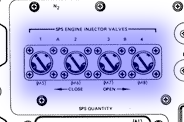
SPS Engine Injector Valve indicators - Panel 3.
076:01:54 Stafford (onboard): Gimbal Motors, Off. TVC Servo Power, Off.
076:02:00 Cernan (onboard): Whew! Babe, I think we's here.
076:02:02 Stafford (onboard): Oh, you know we are.
This is Apollo Control. As Apollo 10 went behind the Moon, we were showing a distance of 256 nautical miles [474 km] from the Moon, velocity of 7,770 feet per second [2,369 m/s] and a spacecraft weight of 93,281 pounds [42,408 kg]. They were in a good Lunar Orbital Insertion burn. We should reacquire Apollo 10 in 20 minutes, 52 seconds; at an elapsed time of 76 hours, 22 minutes, 58 seconds.
076:02:03 Young (onboard): Bus Ties, Open.
076:02:04 Stafford (onboard): Bus Ties, Open.
076:02:05 Cernan (onboard): Okay, Bus Ties.
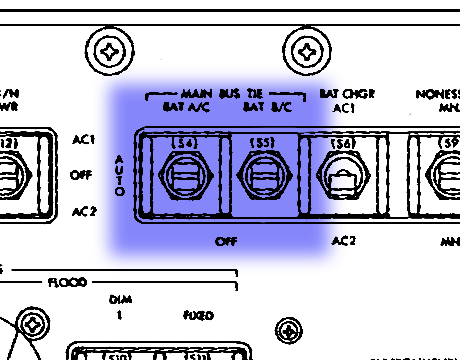
Main Bus Tie switches - Panel 5.
076:02:07 Stafford (onboard): BMAGs, Rate 2. EMS to Standby. Okay, you want to take the readings on the...
076:02:11 Young (onboard): Minus 7 on EMS.
076:02:13 Stafford (onboard): Minus 7 [coughing].
076:02:14 Cernan (onboard): Okay, let me - let me read that stuff. Let me take that stuff.
076:02:17 Young (onboard): (Sigh.)
076:02:18 Cernan (onboard): What is it? Minus 7?
076:02:19 Stafford (onboard): Yes.
076:02:20 Cernan (onboard): What was the burn time, Tom?
076:02:22 Stafford (onboard): The total burn time...
076:02:23 Cernan (onboard): Yes.
076:02:24 Stafford (onboard): ...was 5 minutes and 56 seconds.
076:02:29 Young (onboard): Minus 7 on EMS. I'll turn it Off.
076:02:30 Cernan (onboard): At what? Give it? What was it?
076:02:32 Stafford (onboard): Hot time: 05:56.
076:02:33 Cernan (onboard): I mean, what was the EMS?
076:02:35 Young (onboard): Okay, well, let's proceed out of here, huh?
076:02:36 Stafford (onboard): Let's proceed [garble] proceed.
076:02:37 Cernan (onboard): What was the EMS? Okay. Give me - give me those. Plus 0.1, residuals are...
076:02:44 Stafford (onboard): Zero...
076:02:45 Cernan (onboard): ...zero, minus 0.2. Zero, minus 0.2 of zero.
076:02:49 Stafford (onboard): Okay, go to [garble].
076:02:51 Cernan (onboard): What was Delta-V
C, John?
076:02:54 Young (onboard): Minus 7.
076:02:55 Cernan (onboard): Minus 7?
076:02:56 Young (onboard): Yes.
076:02:57 Cernan (onboard): Not 0.7, but 7?
076:02:58 Young (onboard): 7.
076:02:59 Stafford (onboard): 7 - 7.0.
076:03:01 Cernan (onboard): Okay.
076:03:06 Stafford (onboard): Go to wide deadband.
076:03:07 Young (onboard): Yes.
076:03:20 Young (onboard): We didn't use much gas on that [garble].
076:03:24 Stafford (onboard): Oh, man! Oh, man, look at those shallow craters.
076:03:28 Cernan (onboard): Holy smoley!
076:03:29 Young (onboard): Okay.
076:03:30 Cernan (onboard): I guess we has arrived.
076:03:31 Stafford (onboard): You'd better believe it.
076:03:32 Young (onboard): I'll tell you something. By God, they are craters!
076:03:34 Stafford (onboard): Yes. They sure don't look like it, but they're [garble] shit!
076:03:38 Young (onboard): Get some pictures, you guys.
076:03:39 Cernan (onboard): Yes.
076:03:40 Stafford (onboard): Here. I've got [garble].
076:03:44 Young (onboard): Okay.
076:03:45 Stafford (onboard): Put this watch up over there, [garble].
076:03:48 Young (onboard): Okay; now, let's make sure we've got everything shut off.
076:03:50 Stafford (onboard): Okay, yes.
076:03:51 Young (onboard): Gimbal Motors are Off. The Thrust chambers are Off; the Logic is Off; the TVC Servo Power's Off - You got the Bus Ties, Off, Gene?
076:03:58 Cernan (onboard): Yes, they want you to stay on High Bit Rate?
076:04:01 Young (onboard): I don't - I don't know.
076:04:02 Stafford (onboard): I guess so. Let's look in the Flight Plan.
076:04:07 Cernan (onboard): What's - At - at I - we're crossing 150 at 75:53, which we already did, so - Son of a bitch - we're way over here somewhere.
076:04:14 Young (onboard): That's the weirdest-looking surface - there's some color in that.
076:04:17 Stafford (onboard): There's the coloring C - it's a brownish gray.
076:04:20 Young (onboard): [Garble].
076:04:23 Stafford (onboard): It's a brownish gray, old buddy.
076:04:22 Cernan (onboard): Like a big sandbox, though, isn't it?
076:04:24 Stafford (onboard): Yes.
076:04:25 Cernan (onboard): We is at the Moon, fellows! Can you believe that?
076:04:27 Stafford (onboard): Yes, I can believe it.
076:04:28 Young (onboard): It's a brownish gray.
076:04:29 Cernan (onboard): 60 miles?
076:04:30 Stafford (onboard): And I don't see a level spot in the whole thing. Yes, I guess we might be down close.
076:04:33 Young (onboard): It's fascinating...
076:04:34 Cernan (onboard): Well - what do we do now? [Laughter.] Read the Flight Plan, I guess.
076:04:37 Stafford (onboard): Yes, alright. Let's get back with it. Okay; transfer Verb 66 Enter, when you finish that thing up real fast? Okay? Proceed.
076:04:43 Unidentified Crew member (onboard): [Coughing.]
076:04:44 Stafford (onboard): Proceed.
076:04:47 Young (onboard): We got it.
076:04:48 Stafford (onboard): Oh, did you put a Verb 46 in after that?
076:04:50 Young (onboard): Yes, I did.
076:04:51 Stafford (onboard): You did?
076:04:52 Young (onboard): Yes. I was just - that was the second check.
076:04:54 Stafford (onboard): Okay, good. You got a Verb 66 Enter?
076:04:57 Young (onboard): Yes.
076:04:58 Stafford (onboard): Hold cut-off attitude to 76:00; we're already there. We've got the burn residuals?
076:05:02 Young (onboard): Yes. Then we got to get some other attitudes.
076:05:04 Stafford (onboard): Okay at 76:00 maneuver to roll 180; pitch is the same it's 232; and yaw [garble] three zeros. All we got to do is roll 180. Verb 21; Enter. Just use...
076:05:16 Young (onboard): Well, let's just roll 180, huh?
076:05:18 Stafford (onboard): Yes, [garble].
076:05:20 Young (onboard): Okay?
076:05:21 Stafford (onboard): Yes. Look. There you go. Oh, Translation Control to Lock.
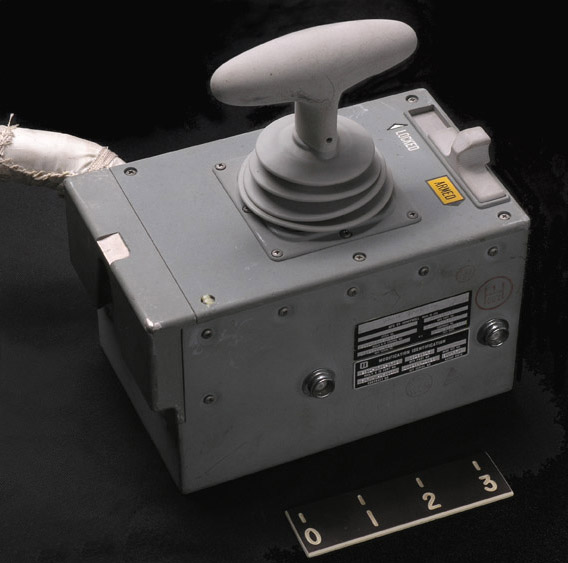
Command Module Translation Control (TLC). The scale is in inches.
076:05:37 Cernan (onboard): Would you believe it? [Sigh.] What about a camera? Try to figure out where the hell we are while you guys are doing that.
076:05:41 Stafford (onboard): Really, I - I don't think you can tell what we're at right now. Until we get acclimated to the thing. We're going to roll 180.
076:05:47 Young (onboard): Man, that is utterly unbelievable!
076:05:51 Cernan (onboard): Isn't that - isn't that something? When I first saw that reflecting in that LM window, I about came unglued!
076:05:56 Young (onboard): I just don't know what to think of that. That's just fantastic!
076:06:00 Cernan (onboard): I about came un - Look at this! Oh, look! Give me that camera, Tom...
076:06:03 Young (onboard): Are we at America?
076:06:04 Stafford (onboard): You got it.
076:06:05 Young (onboard): We're at America, aren't we? Take pictures of that thing.
076:06:07 Cernan (onboard): Give me that camera.
076:06:08 Stafford (onboard): Here, take [garble].
076:06:09 Young (onboard): I - should I be using this one, I wonder?
076:06:10 Stafford (onboard): Don't get much of the horizon.
076:06:11 Young (onboard): Don't get much of the horizon.
076:06:12 Cernan (onboard): The what? Don't get much of horizon?
076:06:14 Stafford (onboard): Take the slide out.
076:06:16 Cernan (onboard): I should probably have the other lens right here.
076:06:20 Young (onboard): By golly, that's fascinating!
076:06:22 Stafford (onboard): That stuff looks gray. It was brownish gray.
076:06:24 Cernan (onboard): It was brownish gray to me.
076:06:26 Stafford (onboard): It's brownish gray.
076:06:27 Cernan (onboard): Oh! What the hell's wrong with it? What the hell is wrong with it?
076:06:30 Young (onboard): You've got to fix it. God damn it, that slide...
076:06:32 Cernan (onboard): The son-of-a-bitch camera, I took the slide out.
076:06:35 Young (onboard): It's that damn thing; you've got to wind it, remember? You got to cock the film...
076:06:38 Stafford (onboard): And it's in black and white...
076:06:39 Cernan (onboard): You wind it which way?
076:06:40 Stafford (onboard): Here. Let me show you.
076:06:42 Stafford/Young (onboard): Take that one, Gene-o.
076:06:43 Stafford (onboard): Then [garble] this one. You wired it for red.
076:06:45 Young (onboard): Okay. When do we get AOS [Acquistion Of Signal], Gene-o?
076:06:48 Cernan (onboard): At 22.
076:06:49 Stafford (onboard): [Garble] white. Okay, you're all set.
076:06:51 Young (onboard): Shoot, I want to take...
076:06:55 Stafford (onboard): Okay, we have AOS at 76:22. Okay?
076:07:04 Young (onboard): Just not much of the horizon there, Gene-o.
076:07:06 Cernan (onboard): I'm not taking any of it, because I don't see it. I got - you know, I think it looks bluish gray.
076:07:16 Young (onboard): By God, we're all satisfied it's got color in it of some kind...
076:07:18 Stafford (onboard): [Garble] color.
076:07:23 Young (onboard): [Garble] brownish to me.
076:07:24 Stafford (onboard): It's a brownish gray.
076:07:25 Young (onboard): I agree with Tom; I think it's got a little brown in it...
076:07:26 Stafford (onboard): It's brownish gray. Very little - occasional white, but mostly brownish gray. And I would say the - the gray predominates - it's 50/50. Hey, as we're coming to right-side up, it's easier to shoot, Gene-o.
076:07:41 Cernan (onboard): Okay. I think - Do we want this lens that - Look at some of those craters!
076:07:45 Young (onboard): Yes.
076:07:46 Cernan (onboard): I tell you, I'd sure like to know where we are.
076:07:48 Stafford (onboard): Well, look; get out the map. You can - you've been trying to work...
076:07:50 Cernan (onboard): [Garble] I got...
076:07:51 Stafford (onboard): ...to get this on...
076:07:52 Cernan (onboard): Hey, look at - look at this thing that's floating with us out this window, Tom. See it?
076:07:55 Stafford (onboard): Yes, I've seen it. It's a big bubble.
076:07:56 Cernan (onboard): A big bubble right with us.
076:07:57 Young (onboard): It's a what? A what?
076:07:58 Stafford (onboard): A bubble.
076:07:59 Young (onboard): Take a picture of that.
076:08:00 Cernan (onboard): A bubble.
076:08:01 Stafford (onboard): Well, there's a bubble from - probably from the urine dump...
076:08:04 Young (onboard): Oh.
076:08:05 Stafford (onboard): ...or something. And then there's a...
076:08:08 Cernan (onboard): I imagine people will think it's a - You want to try this?
076:08:11 Stafford (onboard): No...
076:08:12 Cernan (onboard): See if I can navigate and find out where we are.
076:08:14 Young (onboard): See what Verb 82 says, and write that down.
076:08:16 Young (onboard): Yes.
076:08:17 Cernan (onboard): (Coughing)
076:08:18 Young (onboard): That should be a little better this time...
076:08:20 Cernan (onboard): Let me get that in so I can put it in the postburn report...
076:08:22 Young (onboard): ...6. 169.1 by 59.6. Now, where the hell is it? 1 - 165.
076:08:34 Cernan (onboard): God, it's brown all around that crater there, I swear.
076:08:37 Young (onboard): 1.1 by 59.6.
076:08:40 Stafford (onboard): Yes.
076:08:42 Cernan (onboard): The only thing I didn't like about the whole operation is the unbalanced Mickey Mouse - I never could catch up with it.
076:08:47 Stafford (onboard): Making sure we got a [garble].
076:08:48 Young (onboard): Well, did you get...
076:08:49 Cernan (onboard): You see, it went unbalanced at 300, and then I put decrease, and then I get it to neutral, and then I stopped it; and then it went way up and I never could catch up with it.
076:08:55 Stafford (onboard): Okay, why don't we time - We've got a time hack back there, two pages back.
076:08:59 Young (onboard): Okay, the - this helium pressure went from like 98 to 100...
076:09:03 Cernan (onboard): Let me write that down there.
076:09:04 Young (onboard): ...and 3. It was doing it throughout the burn, just beautiful. And then - with a notable increase...
076:09:11 Cernan (onboard): Oh, hell there. Okay, I'll just pass [garble] all I know...
076:09:16 Stafford (onboard): [Garble]. By God, I'll get that from Jack Schmitt. And I'll clue you. 5.6 now [garble].
076:09:25 Young (onboard): [Garble]...
076:09:26 Stafford (onboard): Hey, you shooting at 5.6, Gene-o?
076:09:29 Cernan (onboard): Yes, I hope so.
076:09:30 Stafford (onboard): Well, it had about f:11 there, when it got - Okay. Well, it looks like Mount Shasta up there; something's definitely [garble] volcanism.
076:09:45 Cernan (onboard): Where?
076:09:46 Stafford (onboard): Well, I - I mean, you can definitely see that, can't you? See that white mound out there?
076:09:50 Cernan (onboard): Yes.
076:09:51 Stafford (onboard): [Garble]. That's definite volcanism [garble]...
076:09:53 Young (onboard): [Garble] and there isn't color in that; it's in black and white.
076:09:56 Cernan (onboard): It's black and (laughter) - Oh, Tom, give me that thing. Let me get this - let me get this fresh crater. Hold on here. This set? You should see this little white one down there.
076:10:11 Stafford (onboard): That's probably [garble] little white one on the peak.
076:10:14 Cernan (onboard): Can you see that? I'm looking right directly at it.
076:10:16 Young (onboard): Yes, I got it. Okay.
076:10:18 Cernan (onboard): That does look like a fresh volcanism because it's black inside.
076:10:22 Young (onboard): Yes, it's black in there.
076:10:26 Cernan (onboard): I guess when we get rolled over, we'll be better than old - This is the first time we'll be sitting upright that we know of.
076:10:31 Young (onboard): Here you are.
076:10:34 Stafford (onboard): What's this? You got the slide in?
076:10:36 Cernan (onboard): It's right in here, Tom. Right there. Look at that ridge; it sits right on the ridge, too.
076:10:46 Young (onboard): My gosh, we ain't very high, you guys.
076:10:49 Cernan (onboard): We don't look it, do we?
076:10:50 Young (onboard): It doesn't look at all high to me (laughter).
076:10:53 Stafford (onboard): Wait until we get down to 10,000 feet.
076:10:57 Cernan (onboard): Holy smoley, down around 10 miles, you're going to...
076:11:00 Young (onboard): These mountains look like they'll reach right up here at us. I never saw anything [garble] This is a little bitty planet, for crying out loud.
076:11:04 Cernan (onboard): It sure is. It sure is.
076:11:08 Stafford (onboard): Okay, let's go ahead. Let's get going; we've got a lot of things to do in the Flight Plan yet.
076:11:12 Young (onboard): I don't know what they all are. Where is the Flight Plan?
076:11:14 Stafford (onboard): Right here.
076:11:17 Cernan (onboard): Okay, and give me that thing, and see if I can help us find out where we are. Okay, I've got the S-band set up to...
076:11:22 Stafford (onboard): Okay, we'll take it. Let me get a time hack back here for these damn things, Gene-o. The time we started at 150 west, 75:52...
076:11:31 Cernan (onboard): I already got that on there. 75:53, the second one.
076:11:34 Stafford (onboard): Okay.
076:11:35 Cernan (onboard): I already got that. Now, where in hell are time [garble]?
076:11:44 Young (onboard): Okay, we done that part.
076:11:48 Cernan (onboard): You're still going backwards, right?
076:11:49 Stafford (onboard): Yes.
076:11:50 Young (onboard): Yes.
076:11:52 Cernan (onboard): Oh, my golly!
076:11:55 Stafford (onboard): We're still going backwards, okay. Now, it's - At 70, we initiate orb-rate - right away 76:17, orb-rate 350, ORDEAL. Let's get the ORDEAL going. Let's go to Lunar and 60 by 170 over the [garble] John. I'll get it. Let's go to Power on the Lunar, take an average [garble].
076:12:16 Young (onboard): Okay, I'll align the GDC to IMU.
076:12:18 Stafford (onboard): Yes, align the GDC to IMU and go to close rate. Then you want to call up Verb 82 - 83, right? I wonder what day it is?
076:12:31 Cernan (onboard): They know we're here, because they would have acquired us at 12. You want me to take something off your hands, Tom?
076:12:43 Stafford (onboard): The stuff get your DAP at 315 [garble] 214. You want me to get it, John?
076:12:50 Young (onboard): Go ahead. You want me to get it?
076:12:56 Cernan (onboard): Yes, the only damn thing I didn't like about that engine was the way it...
076:13:08 Stafford (onboard): It looks like we've got some pretty phenomenal hardware.
076:13:12 Cernan (onboard): God dang, that thing looks [garble].
076:13:14 Young (onboard): It's smooth as silk.
076:13:17 Cernan (onboard): I wonder what our nominal percentage is down there on the [garble].
076:13:21 Young (onboard): Enough to [garble] you back.
076:13:23 Cernan (onboard): I've got 39 per cent.
076:13:24 Young (onboard): That's alright.
076:13:25 Cernan (onboard): I thought we were looking at 47 per cent in the sims all the time. We've got another burn to make, yet.
076:13:32 Stafford (onboard): Yes. 40 per cent.
076:13:38 Cernan (onboard): I thought we were used to looking at 47 percent?
076:13:42 Stafford (onboard): Okay, John, we got to go through - We're coming along like this. Okay, we have a [garble]; right, babe?
076:13:50 Young (onboard): Yes.
076:13:51 Stafford (onboard): Okay. Pitch down to 315 ORDEAL.
076:13:57 Young (onboard): Okay. But that's all slipped 11 minutes because of this time lag.
076:14:01 Stafford (onboard): Yes. That's 76:27. 13 minutes [garble].
076:14:08 Cernan (onboard): I'm on the middle of the [garble].
076:14:15 Unidentified crew member (onboard): (Sigh)
076:14:21 Young (onboard): Pitch down to where? Okay, that's...
076:14:23 Cernan (onboard): 70 degrees.
076:14:36 Young (onboard): Okay, what am I pitching to?
076:14:38 Stafford (onboard): We need to pitch down to 315 inersh [inertial] for ORDEAL.
076:14:44 Young (onboard): [Garble] inertial [garble].
076:14:47 Stafford (onboard): [Garble] need to pitch down.
076:14:50 Young (onboard): Okay.
076:15:05 Cernan (onboard): Got the right what?
076:15:08 Stafford (onboard): So we're going to be upside down coming around the...
076:15:10 Cernan (onboard): Disagrees - This is 37 percent at this temperature and - and pressure, so the helium pressure in the...
076:15:17 Stafford (onboard): So, we've rolled 180, right?
076:15:18 Young (onboard): Yes.
076:15:19 Stafford (onboard): Then we will swing down through the straight vertical; right, babe?
076:15:23 Cernan (onboard): Yes.
076:15:24 Stafford (onboard): Then we'll come over like that.
076:15:25 Cernan (onboard): Yes.
076:15:26 Stafford (onboard): Until we come into that [garble].
076:15:27 Cernan (onboard): Yes.
076:15:28 Stafford (onboard): Alright?
076:15:29 Cernan (onboard): Yes.
076:15:30 Young (onboard): Get some pictures of this, while we're pitching over; we'll probably never do this again.
076:15:33 Cernan (onboard): Yes, okay. Want to try that other lens or do you want to use this one entirely?
076:15:42 Young (onboard): Oh, boy!
076:15:43 Stafford (onboard): Black skies - Let's see, and we'll acquire at 20 minutes.
076:15:49 Young (onboard): It's the weirdest thing I ever saw in my life. This is worth the price, boy.
076:16:07 Cernan (onboard): Isn't it? I'll tell you - 60 miles looks like you're awful close to me.
076:16:15 Stafford (onboard): Do you recognize any stuff I got you?
076:16:17 Young (onboard): Yes. There's the Tallahatchie Bridge.
076:16:21 Cernan (onboard): Did you find it?
076:16:22 Young (onboard): Yes. That's my big basin. It is a big basin! Look at those sides!
076:16:28 Cernan (onboard): Where you looking, on the...
076:16:29 Young (onboard): Right up there.
076:16:30 Stafford (onboard): Oh, that whole thing?
076:16:31 Young (onboard): Yes, that whole great big thing.
076:16:33 Cernan (onboard): What latitude is that at, babe?
076:16:35 Young (onboard): I don't know; I have no idea where we're at.
076:16:39 Cernan (onboard): I should have - I - I should get my lunar - lunar chart. I've got it marked a little bit more. This is - this is - this is where the target of opportunity.
076:16:47 Young (onboard): When we have to be there?
076:16:53 Cernan (onboard): Would you believe where we are, guys?
076:16:54 Stafford (onboard): Huh? Yes, [garble] at.
076:16:56 Cernan (onboard): Would you believe where the hell we are?
076:16:58 Stafford (onboard): We've got a lot of work to do, too.
076:17:00 Cernan (onboard): I agree with you.
076:17:03 Stafford (onboard): Old Jack will flip just over that one volcano.
076:17:07 Cernan (onboard): That had to be a...
076:17:08 Stafford (onboard): Oh, yes. You could see the flows coming out of the top, and [garble]...
076:17:10 Cernan (onboard): Tom, get that one right there. It was sure black, wasn't it? We're going backwards. Let me see what the hell we're looking at? I wish...
076:17:18 Young (onboard): At least take some of that in color, so it shows up in color.
076:17:21 Cernan (onboard): Yes.
076:17:22 Young (onboard): That what-you-call-it.
076:17:24 Cernan (onboard): We come back around just the same.
076:17:34 Stafford (onboard): We need that 250?
076:17:39 Young (onboard): How's the water boiler doing there, Gene-o, babe?
076:17:43 Cernan (onboard): The water boiler's not boiling yet, because we still got good temperatures.
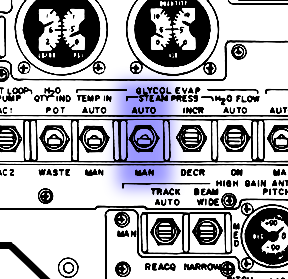
Glycol Evap-Steam Press switch - Panel 2.
076:17:46 Stafford (onboard): Wonder what the temperatures are. Hey, there's another little one for Jack to look at. We're going to keep him busy for years.
076:17:52 Cernan (onboard): Oh, give me - give me this one. This has got a - this has got a raw - it looks like a rocky basin in it. On this crater here, Tom. Where is 315 ORDEAL, Tom?
076:18:02 Stafford (onboard): Let me check it. Right around here.
076:18:04 Young (onboard): We should be up to 70 - 3, Enter. You got that set up on ORDEAL?
076:18:13 Stafford (onboard): Yes.
076:18:14 Young (onboard): Why's this one here doing it, too?
076:18:16 Stafford (onboard): Number 2's Inertial; Power's - Auto; is EMS, Off? EMS - I mean ORDEAL? I got the power to it - in Lunar.
076:18:27 Cernan (onboard): Why, those sides don't look - look rocky, you can see the bottom of that.
076:18:31 Stafford (onboard): It could be.
076:18:34 Young (onboard): Hey, what's going on there?
076:18:36 Stafford/Cernan (onboard): 263.
076:18:39 Stafford (onboard): You see Inertial is about equal to orb-rate there, babe.
076:18:43 Cernan (onboard): I'm coming backwards, so this stuff's got to be...
076:18:46 Stafford (onboard): That's right. Look at...
076:18:47 Cernan (onboard): ...over here.
076:18:48 Stafford (onboard): Okay.
076:18:49 Cernan (onboard): Okay?
076:18:50 Stafford (onboard): Yes.
076:18:51 Young (onboard): That had me a little worried.
076:18:52 Stafford (onboard): Yes, I understand. You guys - You see, we're going to be going upside down; we're now going straight down over the subsolar point.
076:19:01 Cernan (onboard): We certainly in hell ought to be able to pick out - Tom, you know that lunar map we got in that case? If you could reach up and grab that for me, that's a - then we'd each have one, and that's - our LM lunar map. I don't mean our strip chart, but I mean the...
076:19:12 Young (onboard): Give me - give me - give me a - give me a - give me a - a thing.
076:19:16 Cernan (onboard): That?
076:19:17 Stafford (onboard): The camera, Go.
076:19:20 Cernan (onboard): Then - then I could follow that other chart which I've got marked a lot better. I'd like to find Neper when we come around on...
076:19:25 Young (onboard): I'll get it, Tom. Where is that thing? In here somewhere?
076:19:27 Stafford (onboard): Yes, it's right in there. I want to see this one.
076:19:40 Young (onboard): That's black...
076:19:41 Stafford (onboard): There's stuff in there.
076:19:42 Cernan (onboard): That's black stuff, I can see it from here.
076:19:43 Young (onboard): That black...
076:19:45 Stafford (onboard): I've got another one - Hold it, John. I got a good one for Gene - Hold that. Yes, it's black as hell in some of that stuff.
076:20:06 Cernan (onboard): Ever see anything like this in your life?
076:20:08 Young (onboard): (Laughter) Obviously not!
076:20:11 Stafford (onboard): We're coming up to the subsolar point. Okay.
076:20:17 Cernan (onboard): Okay.
076:20:18 Young (onboard): That damn thing right there is nothing but a big hill that it looks like damn...
076:20:24 Stafford (onboard): Oh, look at that!
076:20:25 Young (onboard): ...it looks like one of the volcanoes in Arizona!
076:20:26 Stafford (onboard): That one over there.
076:20:28 Cernan (onboard): There's another fresh one, Tom. Let me get this fresh one over here with this...
076:20:30 Stafford (onboard): Yes, I've got one now.
076:20:33 Young (onboard): Watch for the horizon, babe.
076:20:34 Stafford (onboard): I don't even have the horizon...
076:20:35 Cernan (onboard): What happens if you get the horizon in?
076:20:37 Young (onboard): They take off points.
076:20:38 Cernan (onboard): Well, here's a rim crater on a rim crater. This is the one I want to track, yes.
076:20:45 Young (onboard): When does Houston supposed to come into view?
076:20:47 Stafford (onboard): Oh, look at that! What's that big crater over there?
076:20:49 Young (onboard): Well, when's AOS, you guys? (Laughter)
076:20:51 Stafford/Cernan (onboard): At 22.
076:20:52 Stafford (onboard): I think the best thing to say - [garble] Houston, tell the Earth we have arrived. Don't go into the rest of it.
076:21:02 Cernan (onboard): Here, you want this? I'm going to try and find out - We're at the subsolar point. God dang, you can't really see much! Look at! Get that one straight down, Tom, at subsolar. Can you see that little white one?
076:21:11 Stafford (onboard): I've got it.
076:21:14 Cernan (onboard): John, where would you say subsolar is on there? In longitude?
076:21:19 Young (onboard): Babe, now, don't - don't be asking me things like that, I can't - -
076:21:22 Cernan (onboard): It must be about 90 degrees, huh?
076:21:24 Stafford (onboard): Yes. What do we have - We're in PGNS to reacquire?
076:21:30 Cernan (onboard): Okay.
076:21:31 Stafford (onboard): Let's stand by to give them the burn (report). And also, to tell them that we have arrived.
076:21:37 Cernan (onboard): Where's the Flight Plan, so I can give them all that jazz? You say when. Give me the Flight Plan, John. You got it in here? You keep the nav, I'll take the flight.
076:21:46 Stafford (onboard): Okay, you can stop them pretty soon, John.
076:21:48 Young (onboard): Okay.
076:21:50 Stafford (onboard): Keep it upside down. And we should be going right down the Apollo Zone.
076:21:53 Young (onboard): Okay.
076:21:55 Stafford (onboard): Okay.
076:21:56 Cernan (onboard): We ought to be looking coming - We're still going backwards.
076:21:58 Young (onboard): You got your tick-tock going there? Do you know what time it is from when we started 150 west?
076:22:05 Cernan (onboard): No, I didn't time it, babe, but - I know the time. I know that the time's on the chart at 53 - is at 75:53. I marked it on there.
076:22:15 Stafford (onboard): 75:53; and at 23, it will be 30 minutes after that, right?
076:22:20 Cernan (onboard): Yes.
076:22:21 Stafford (onboard): Where do we start? There's 10 minutes, 20 minutes; okay, here's where we should be coming up to right now. 30 minutes, right here. Okay. Of course, we are coming - we're upside down, right? Going forwards.
076:22:34 Young (onboard): Yes. Look at that planet, look at that thing there?
076:22:36 Cernan (onboard): Yes.
076:22:38 Young (onboard): Hey, that's something isn't it?
076:22:39 Stafford (onboard): Here's another volcano for - for Jack to look at. There's no doubt that there's a...
076:22:43 Cernan (onboard): There's two of them. See them together?
076:22:44 Stafford (onboard): We got...
076:22:45 Young (onboard): Oh, no, that doesn't - that's not - that little white one, Tom?
076:22:49 Stafford (onboard): Yes, I was wondering...
076:22:50 Cernan (onboard): That - that with all those rays; that's got to be an impact crater or something like that, I'll bet.
076:22:52 Stafford (onboard): But why is it going up high?
076:22:54 Young (onboard): Well, I can't tell that it is, looking down at the subsolar.
076:23:00 Stafford (onboard): Okay, stop it, José.
076:23:02 Young (onboard): Yes. We're stopped.
076:23:04 Cernan (onboard): Hey, John? You ought to be able to see a big, big Neper on your left somewhere.
